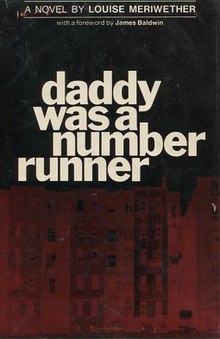 First edition First edition | |
| Author | Louise Meriwether |
|---|---|
| Language | English |
| Published | 1970 |
| Publisher | Prentice Hall |
| Publication place | United States |
| Followed by | The Freedom Ship of Robert Smalls |
Daddy Was a Number Runner is the first novel by American writer Louise Meriwether. It was published by Prentice Hall, with a foreword by James Baldwin, in 1970, and is now considered a modern classic. It depicts a poor black family in Harlem during the Great Depression in the first half of the 20th century, as seen through the eyes of a 12-year-old African-American girl who has one brother who wants to be a chemist and another who is a gang member.
Reception
Paule Marshall said of the book:
greatest achievement lies in the sense of black life that it conveys: vitality and force behind the despair. It celebrates the positive values behind the black experience: the tenderness and love that often lie underneath the abrasive surfaces of relationships … the humor that has long been an important part of the black survival kit, and the heroism of ordinary folk … a most important novel.
It was an Essence Book Club Choice in December 2002.
References
- Daddy Was a Number Runner at Goodreads.
- Rita B. Dandridge, "From Economic Insecurity to Disintegration: A Study of Character in Louise Meriwether's Daddy was a Number Runner", Negro American Literature Forum, Vol. 9, No. 3 (Autumn 1975), pp. 82–85.
- Erica Bauermeister, Jesse Larsen and Holly Smith (eds), 500 Great Books by Women, Penguin Books, 1994, pp. 123–24.
- Louise Meriwether page, African American Literature Book Club.
Further reading
- Demirtürk, E. Lâle, "Writing the Urban Discourse into the Black Ghetto Imaginary: Louise Meriwether's 'Daddy Was a Number Runner'", Southern Literary Journal, Autumn 2006, Vol. 39 Issue 1, p. 71.
This article about an American novel is a stub. You can help Misplaced Pages by expanding it. See guidelines for writing about novels. Further suggestions might be found on the article's talk page. |